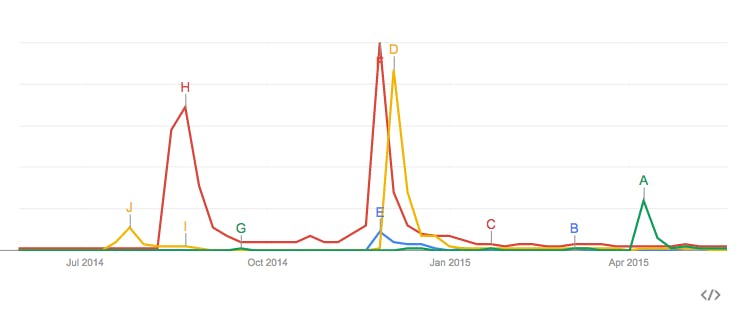The story of 12-year-old Tamir Rice is the nightmare of any parent. While playing outside his Cleveland neighborhood last November, a local resident worried the airsoft rifle in his hands was a real gun and alerted authorities. Upon arriving at the scene, and officer waited merely a few seconds before putting two bullets into Tamir Rice.
Video footage of the scene shows both officers Timothy Loehmann and Frank Garmback refusing to administer first aid and even tackling and handcuffing Tamir’s 14-year-old sister as she runs to help him.
https://www.youtube.com/watch?v=sdAYPQd1H1A
Making the tragedy of the event itself even worse is the lethargic pace at which the Cleveland Police Department has handled the investigation. After two months of no news from Cleveland police, the department handed the investigation to the County Sheriff. Four months after Rice’s death, the city of Cleveland responded to the Rice family’s wrongful death suit by blaming Rice’s “failure…to exercise due care to avoid injury.” In the fifth month, Rice’s mother Samaria moved into a homeless shelter to avoid living “next door to the killing fields of her son.”
During all of this, the Rice family paid to keep young Tamir’s body preserved in the hope of further medical examination. Unable to continue to shoulder that expense, Tamir Rice was cremated earlier this week. Six months after Rice’s death, investigators have not even questioned Loehmann or his partner.
The story of 12-year-old Tamir Rice is the nightmare of any parent.
This tragedy has been followed by shockingly sparse media coverage of the event. Although the deaths of Michael Brown, Eric Garner, Walter Scott, and many others have brought widespread protests and wall-to-wall Twitter protests, the cold-blooded killing of a 12-year-old earned comparatively little attention from any major media outlet.
In fact, a comparison using a Google Trends analysis of news headlines finds massive spurts in coverage following the deaths of Brown (in red), Garner (yellow), and Scott (green). When weighed against these events, the death of Tamir Rice was clearly put on the backburner.
It’s very likely this lack of media coverage has had a direct effect on the slack investigation by the Cuyahoga County Sheriff’s Department. As was the case in Ferguson, Mo., Staten Island, and Baltimore, police investigations are often driven by mass public reaction, an outcry enhanced by the amount of media coverage of an event.
According to a study by Policing, an academic journal focusing on law enforcement, those who read an even-keeled article about an incident of police brutality were far more likely to assume the officer was guilty. A study from The Journal of Humanities & Social Sciences found a similar effect on overall perception of police.
When weighed against these events, the death of Tamir Rice was clearly put on the backburner.
In its advice to police departments handling the media during an investigation, the Federal Bureau of Investigations warns that public opinion of an investigation is “often driven by media coverage and sometimes influenced by a long-standing bias and mistrust of government.”
In this way, the media’s decision to largely ignore Tamir Rice’s death has created an environment in which investigators have little public pressure to act, at least compared to the enormous outcry in Baltimore or South Charleston. What that leaves us to wonder is why Rice’s death has become so differentiated from the deaths of Brown, Garner, Scott, and Freddie Gray, especially considering Rice is the only victim who was a minor at the time of his death.
Aside from his age, few factors separate Rice’s death from others heavily covered by the mainstream media. For one, the entire scene of his death was recorded by nearby security cameras, creating what was rather gruesome and disturbing content for a cable news network to air. As others have pointed out, the media ran the equally brutal video of Walter Scott’s death like it was a football replay.
While media outlets might be understandably sensitive to airing the death of a child, it’s a poor excuse for ignoring the story wholesale. After all, the rise of ISIS in the Middle East has been one of the most widely covered stories in the past year, even despite its close association with extreme violence.
Given the “if it bleeds, it leads” mantra of modern media, one could, thus, say the video of Rice’s death would only encourage the media to share the extreme circumstances surrounding his death, just like it did in the case of Walter Scott.
The media’s decision to largely ignore Tamir Rice’s death has created an environment in which investigators have little public pressure to act.
The other deciding factor in the media’s coverage of Rice is likely the fake weapon held by Rice when the two officers confronted him. Police were first alerted to Rice’s presence when a 911 call reported someone with a “probably fake” gun pointing it at random people. When officers approached Rice, as the video shows, he never raised what turned out to be an airsoft gun with the orange markings removed.
Nevertheless, Officer Timothy Loehmann shot two bullets into Rice mere seconds after leaving his patrol car.
Mistaking a toy gun for a real gun by police rarely results in the death of a child, but it does happen. In an eerily similar case from October 2013, 13-year-old Andy Lopez of Sonoma County, Calif., was shot and killed by a police officer after a toy pellet gun was confused for a real assault rifle. In 2007, a 12-year-old West Memphis child was shot and killed after pointing a toy gun at police.
And in 2006, a Fort Worth, Texas police department had four incidents wherein they nearly shot teenagers wielding fake toy guns.
Each of these instances is treated as a tragedy, but charges are rarely pressed against the officer. As Dr. Bill Lewinski—an expert on stress reactions in police officers—states, “Speaking from a physiological standpoint, it’s virtually impossible for an officer to visually distinguish between a real gun and a fake one when faced with something that looks as realistic as some of the ‘toy’ guns on the market.”
The public, thus, tends to forgive the officers and see it as an instinctual act for survival, a mistake anyone could make. Perhaps viewing Tamir Rice’s death as yet another avoidable but blameless tragedy, the media has left Cleveland behind them.
Except Tamir Rice never pointed his gun at the Loehmann or his partner. In fact, he wouldn’t have had time to—estimates of the time it took Loehmann to leave the car and discharge his gun are betwen 1.5-2 seconds. It’s hardly enough time to consider whether this situation is worthy of deadly force, let alone if the child holding a gun is wielding a real deadly weapon or a toy one.
The public, thus, tends to forgive the officers and see it as an instinctual act for survival, a mistake anyone could make.
Seth Stoughton, a law professor specializing in policing, called the handling of the situation “a use of horrible tactics” and expressed shock they did not “park at a safe distance and walk up, using cover and concealment, and try to initiate communication at a distance.”
Despite the false excuses offered by both the Cleveland Police Department and the Cuyahoga County Sheriff’s office, it’s clear this tragedy deserves its due attention, both from investigators and the media. The scale of its impact is only deepened by Tamir Rice’s young age, but it’s made a criminal travesty when investigators continue to be negligent and insensitive to the suffering of Tamir Rice’s family.
If the media wants to pride itself on covering the waves of dead black males at the hands of police, it can’t reasonably hope to do so without filling the hole they’ve left where justice for Tamir Rice should be.
Gillian Branstetter is a social commentator with a focus on the intersection of technology, security, and politics. Her work has appeared in the Washington Post, Business Insider, Salon, the Week, and xoJane. She attended Pennsylvania State University. Follow her on Twitter @GillBranstetter.
Photo via joelogon/Flickr (CC BY SA 2.0)

